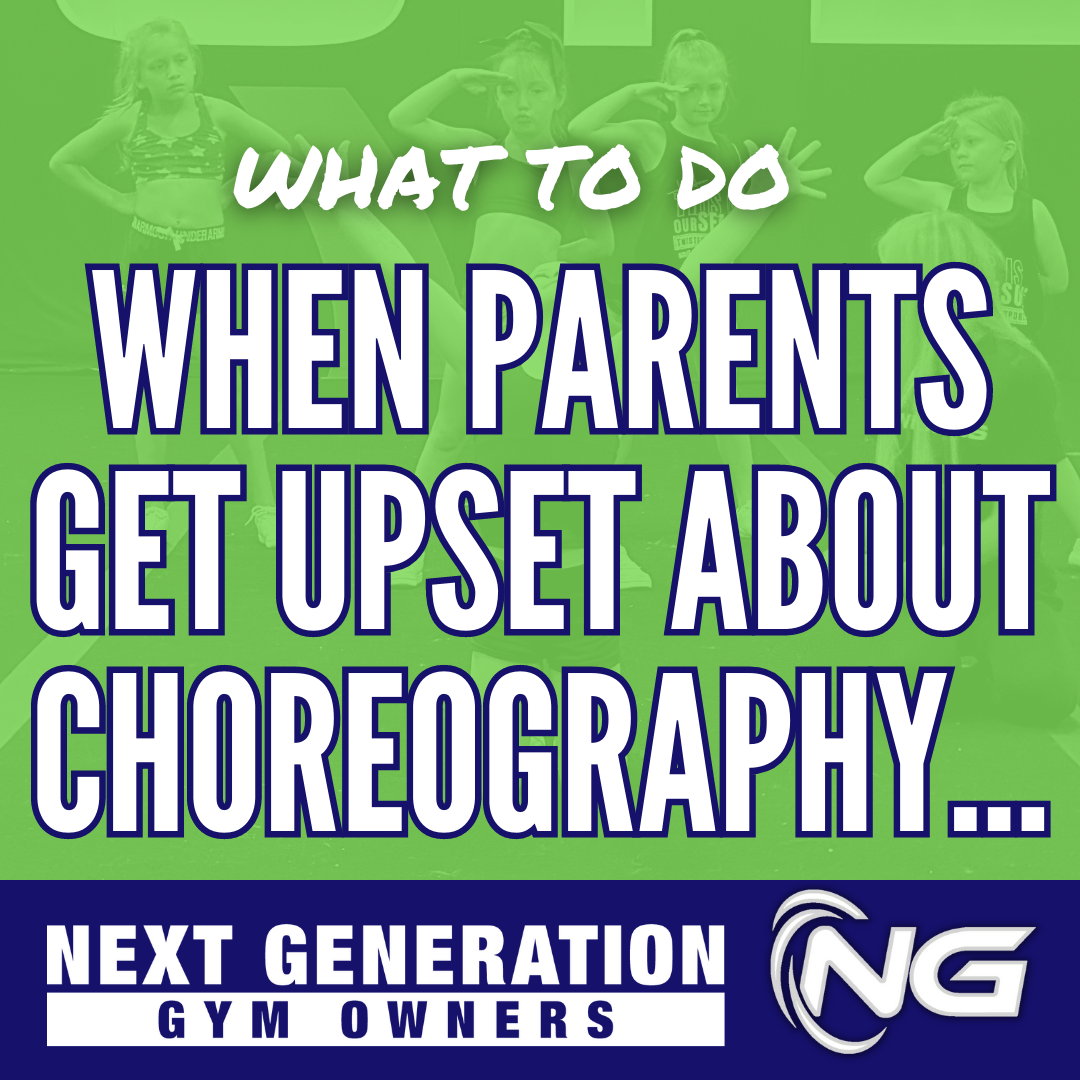As I mentioned yesterday, the parents in my gym often stay during choreography. Most of them sit and socialize, get snacks ready for the kids and work remotely from the gym.
We’ve set up good boundaries for our kids, though we’re working on making them a little better for the younger athletes. At times, we find that they keep water bottles at the table with mom and take entirely too long grabbing a drink, but we’re working through those boundaries to make them better each week.
Every so often, we find an educational opportunity for our parents. Yes, that’s what I’m calling it when a parent isn’t thrilled with something they see happening out on the floor.
This week we found some great new opportunities to educate our parents on things in our program. One parent was a fairly new parent, while another was a long-time veteran parent. The first was a mom who hasn’t previously attended choreography, so she didn’t quite understand what to expect. Our sessions run for several hours at a time, but she didn’t realize the choreographer works with one group, and then they sit and relax while she moves over to the other group (mostly during dance). On our older teams, they step aside and practice their skills. On younger teams, our coaches learn the choreography so they can work with the athletes. We keep them busy, but when you’re 3-4 hours in, sometimes it’s just OK to let their brains and bodies rest for a bit. So, when a choreographer is working dance with one group, we don’t always review with the other group. It’s something we play by ear based on our perception of the athletes’ individual limits and retention of the routine.
One parent who wasn’t super familiar with cheer took this as the athletes not being in that portion of dance. Meaning, she thought a couple of the athletes in that section were just nuggetting for 8-counts on end. She later reached out to those parents to warn them that might be the case for their child.
Luckily, we’ve got a great culture in our gym. The mom of the athlete who was perceived to be nuggeting reached out. The coach was able to explain what the first mom may have been confused by, and it was over. The next morning before choreography began, the coach gathered the parents and explained what choreography often looks like and why an athlete may be off to the side while a choreographer is working with a specific group of athletes.
Were we mad at the mom who had it wrong? No, not really. She just didn’t understand. In the future, my guess is that she’ll come to us with questions rather than assumptions based on how the coach handled the situation.
In another situation, a parent was concerned her daughter, who had just made senior 3 as a flyer, wasn’t getting enough opportunities. During choreography, our gym manager walked through the lobby and chatted with parents for a few minutes. This is just what we do in our gym. We never pass by without offering eye contact or a greeting. If someone is there for hours, we spend a few minutes just chatting. This allows parents to feel comfortable when they have questions or concerns. The mom of the flyer expressed concerns to the gym manager. When choreography was wrapping up, the coach was able to spend a few minutes with the parent explaining that it’s normal for a flyer on a new level to fly some things, but not all. Other athletes had made their way into the position in the same way, and were now well-versed in that level. Her daughter, who had never competed level three before, would get plenty of opportunities to learn throughout the season, but it’s normal to not fly every single skill – especially with the nature of the scoresheet as is.
Was I mad the mom thought her daughter was getting the short end of the stick? No way! I get it. She wanted every opportunity for her daughter to learn. I felt the same last year, when my daughter was the newbie on that team and wasn’t flying one of the stunts and just doing a prep for part of pyramid. Was I disappointed? Of course. I can empathize with her like any mom would. But, I also got to experience first-hand how much my daughter grew that season and without all the stress of having to not just learn new skills, but MASTER new skills in just four short months before we competed.
Parents want good things for their kids. Good parents want good things for their child’s teammates also. If you can develop an open-door culture with a staff who will stop and make time to listen, you’ll find far less people bottling up their feelings. Both of these situations could have turned into moms who bottled them up, feeling like every move was a slant against their kids.
As a gym owner, it’s important that you and your staff are building a positive gym culture by doing the following:
- Letting things “play out” rarely solves problems. Instead, address concerns (or even things you think might develop into concerns) early on.
- Don’t assume they are trying to be difficult, but it’s fair to assume they want good opportunities for their kids and their child’s teammates. It’s important to be able to see their perspective and address their concerns as a team. You want opportunities for the kids as well. You’re on the same team, but in a gym with poor culture, it probably doesn’t feel that way. It’s important to listen 75 percent and speak 25 percent of the time. Hear them out, and make a plan for how the child can get those opportunities over time. At the end of the day, it’s not about IF a child will get the opportunities, but WHEN. Remind the parent, everything is about timing, and if you’re on the same team fighting for the best interest of the kids, the timing will come along!
- People first. Cheer second. When we put people first, they enjoy cheer more. When they enjoy cheer, they will commit more time and energy to it. When you put cheer first, people feel like a number.
- Educate your parents. Look at every potential conflict as an opportunity for education. I don’t mean “educate” by putting a new policy in your packet either. I mean “educate” by telling them what to expect. Have a meeting or host a live video and talk about what choreography will look like (next year I’m going to do that!) In my first practice with my team, I had a handout about what to expect with our practices, my expectations and how to reach out if you had any questions or concerns. I hosted a 10 minute meeting the first part of practice with parents and kids. We went through the sheet and handed everyone a copy. Last week a parent mentioned her daughter was frustrated she wasn’t getting to fly all the skills. I reminded her of what Max 4 was, and how her daughter was intended to fly pyramid, which we hadn’t worked on yet. I politely reminded her of the meeting we had where I went over that, the handout and our one-on-one conversation about realistic expectations of her daughter flying this year. Once I did that, she was professional, polite and kind. She was disappointed, but she understood we had made it clear. I also opened the door for her to provide feedback if there had been other ways I could have clarified that. I’m not above feedback! I welcome it.
Maybe your parents don’t stay for choreography, so this isn’t really an issue for you. I bet 100 percent of gyms will encounter this once this season though. You will have a parent who is wanting the best for their children and the children on the team. If you can help them see you’re a team – the coaches, the parents and the athletes – you’ll be able to develop an amazing culture in your gym where everyone works together with the best interest of the kids in mind.
If your gym could use some help on gym culture and developing education for your families, reach out. The coaches in the Next Gen Academy can help you build a great culture that inevitably leads to growth in your all star program. Learn more and book a call at nextgenowners.com/book-a-call.









